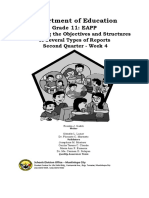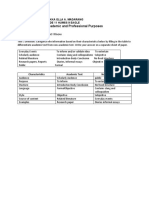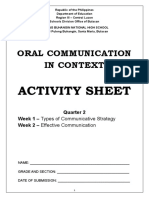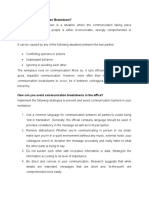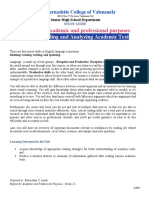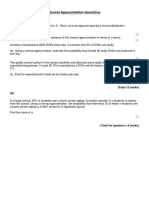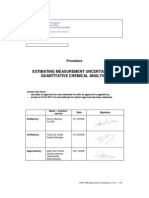Eapp q2 Module 6 Research
Eapp q2 Module 6 Research
Uploaded by
Rica Anette MañozoCopyright:
Available Formats
Eapp q2 Module 6 Research
Eapp q2 Module 6 Research
Uploaded by
Rica Anette MañozoOriginal Title
Copyright
Available Formats
Share this document
Did you find this document useful?
Is this content inappropriate?
Copyright:
Available Formats
Eapp q2 Module 6 Research
Eapp q2 Module 6 Research
Uploaded by
Rica Anette MañozoCopyright:
Available Formats
lOMoARcPSD|14966748
EAPP Q2 Module 6 - Research
Philosophical Foundations in Education (La Consolacion University Philippines)
Studocu is not sponsored or endorsed by any college or university
Downloaded by Rica Anette Mañozo (acirmarco18@gmail.com)
lOMoARcPSD|14966748
www.shsph.blogspot.com
Downloaded by Rica Anette Mañozo (acirmarco18@gmail.com)
lOMoARcPSD|14966748
www.shsph.blogspot.com
ENGLISH FOR ACADEMIC AND PROFESSIONAL PURPOSES – GRADE 11/12
Quarter 2 – Module 6: CONDUCTS SURVEYS, EXPERIMENTS OR OBSERVATIONS
Republic Act 8293, section 176 states that: No copyright shall subsist in any work
of the Government of the Philippines. However, prior approval of the government agency or
office wherein the work is created shall be necessary for exploitation of such work for profit.
Such agency or office may, among other things, impose as a condition the payment of
royalties.
Borrowed materials (i.e., songs, stories, poems, pictures, photos, brand names,
trademarks, etc.) included in this book are owned by their respective copyright holders.
Every effort has been exerted to locate and seek permission to use these materials from
their respective copyright owners. The publisher and authors do not represent nor claim
ownership over them.
Regional Director: Gilbert T. Sadsad
Assistant Regional Director: Jessie L. Amin
Development Team of the Module
Writer: DARWIN S. ARIATE
Editors: GINA B. PANTINO
JOSALIE T. TONIO
SONIA V. PRENSADER
LORAINE T. CHIONG
Reviewers: GINA B. PANTINO and
Masbate City Division headed by JEANETTE ROMBLON
Illustrator / Layout Artist: JOHN MICHAEL P. SARTE
Downloaded by Rica Anette Mañozo (acirmarco18@gmail.com)
lOMoARcPSD|14966748
www.shsph.blogspot.com
SHS
English for Academic
and Professional
Purposes
Quarter 2 – Module 6
CONDUCTS SURVEYS, EXPERIMENTS
OR OBSERVATIONS
This instructional material was developed based from the Most Essential
Learning Competencies (MELC) in English for Academic and Professional
Purposes in response to the new normal scheme in learning delivery of the
Department of Education. This module was collaboratively reviewed by
educators and program specialists in the Regional Office V. We encourage
teachers and other educational stakeholders to email their feedback,
comments, and recommendations to the Department of Education at
____________________.
We value your feedback and recommendations.
Department of Education Republic of the Philippine
1
Downloaded by Rica Anette Mañozo (acirmarco18@gmail.com)
lOMoARcPSD|14966748
www.shsph.blogspot.com
I. Introduction:
You have explored the nature and purpose of designing a
questionnaire, and now you are ready to explore methods of data
collection. There are varieties of methods of data collection including
observations, experiments, surveys, and others. The most common
methods used are experiments, observations, and surveys. The
purpose of this lesson is for you to explore methods of data collection,
how they work in practice, the purpose of each, when their use is
appropriate, and what they can offer to your research. According to
Gena Showalter – “Giving up is the only sure to fail.” So let’s keep
fighting.
II. Objective:
At the end of this lesson, you are expected to:
Conducts surveys, experiments, or observations
III. Vocabulary List:
Let’s enrich your vocabulary with these terms that you will
encounter throughout this lesson.
Survey – measure characteristics of interest about a population using
selected sample without making connections between the data.
Observation – researchers determine whether an existing condition called a
factor is related to a characteristics of interest
Data – information gathered from the respondents/participants
Experiment – researchers create a condition by applying a treatment and
seeing if it has any effect on characteristics of interest.
Population – a group of individuals, institutions, objects and so forth with
common characteristics that are the interest of a researcher.
Biased Questions – the wording may lead the respondent to think a certain
way.
Control Group – is the group that does not get the treatment or is not given
special instructions to follow.
Treatment Group – is the group that gets the treatment or is given special
instructions to follow.
Skewed Data - it is when a curve appears distorted in a statistical
distribution.
Downloaded by Rica Anette Mañozo (acirmarco18@gmail.com)
lOMoARcPSD|14966748
www.shsph.blogspot.com
IV. Pre-Test:
Multiple Choice : Write the letter of your choice in your answer
sheet or in your notebook.
1. Which of the following is a true observation?
a. It takes less time than interviews
b. It is often not possible to determine exactly why people behave
as they do
c. Covert observation raises fewer ethical concerns than overt.
d. All of the above.
2. When conducting an interview, asking questions such as: “What
else? Or ‘Could you expand on that?’ are all forms of:
a. Structured responses
b. Category questions
c. Protocols
d. Probes
3. Interviewing is the favoured approach EXCEPT when:
a. There is a need for highly personalized data
b. It is important to ask supplementary questions
c. High numbers of respondents are needed
d. Respondents have difficulty with written language
4. What type of survey question encourages an answer phrased in the
respondent’s own words?
a. Scan-Ended
b. Close-Ended
c. Talk-Ended
d. Open-Ended
5. Interview questions should:
a. Lead the respondent
b. Probe sensitive issues
c. Be delivered in a neutral tone
d. Test the respondents’ power of memory
Downloaded by Rica Anette Mañozo (acirmarco18@gmail.com)
lOMoARcPSD|14966748
www.shsph.blogspot.com
V. Learning Concept:
Today, you are going to learn the three different ways on how to
conduct surveys, experiments, or observations.
The first method you have is a SURVEY. In doing a survey, the
researcher must understand the right mode of inquiry for establishing an
inference whether in a large group of people or from a small number of
people in a group. The very aim of conducting a survey is to present and
explain the actual experiences of a certain population.
Conducting survey is done in three (3) steps: 1) by email; 2) telephone;
3) personal interview. The method of data collection can be from observation
to content analysis and this can be used in the survey.
The challenges limitations of a survey are seen according to the
following criteria: 1) appropriateness of the method; 2) accuracy of what to
observe; 3) generalizability of findings; 4) administrative constrains; 5)
ethical and political difficulties.
An example of a survey is the open-ended questions. This is placed in
a box form and will permit your respondents to provide a unique answer.
This kind of approach is able to provide the respondents the freedom to say
what they feel about a topic, which provided you with an exploratory data
that may unleash important issues, opportunities, issues, or quotes.
(Buensuceso, Dacanay, Manalo, and San Gabriel, 2016, p101)
Let’s consider this example:
You want to know what proportion of your English class likes rock
music. You have three different ways to conduct a study and you need to
look at the key features of each different method, the pros and cons and
decide which method is best.
You already know that a survey means that you are going to select
people. And in this case those people would be in the English class because
that is your population and then you will ask them questions or multiple
questions depending on what you‘re looking for. In this example, you would
randomly select people and you could ask, for example “Do you like rock
music?”
So the positive side of this method is that it’s very time efficient. It’s
very quick to just come up with a question, ask someone a question and get
their answer then record it. This is also nice because you get the right to the
point in your question, you’re designing the question to get the exact
information you’re looking for so it focuses on the desired response.
The negative side of the survey is it’s very likely you could get biased
responses and remember biased responses caused us to get skewed data
Downloaded by Rica Anette Mañozo (acirmarco18@gmail.com)
lOMoARcPSD|14966748
www.shsph.blogspot.com
and the reason you could get a biased response is because when you ask
someone a question the wording is very important. The wording of the
question or the way someone interprets your question can cause you to have
biased responses. So you have to careful with how you will ask and
formulate your question/s.
So for example, if you ask someone, “Do you like rock music?”
You might be biased towards saying YES or NO depending on how they feel
about rock music; whereas, maybe if you had them rank different kinds of
music and gave them different options that would give you a better idea on
how they really feel about this type of music.
So you have to be careful when conducting a survey. Make sure
the wording of your question is not going to cause someone to answer in a
different way.
The second method you have is OBSERVATION. According to
Buensuceso, Dacanay, Manalo, and San Gabriel (2016), Observation
may take place in natural settings and involve the researcher taking lengthy
and descriptive notes of what is happening.
It is argued that there are limits to the situations that can be observed
in their ‘natural’ settings and that the presence of the researcher may lead
to problems with validity.
Limitations with observation include:
a. Change in people’s behavior when they know they are being observed.
b. A ‘snap shot’ view of a whole situation
c. Think Big Brother…
d. The researcher may miss something while they are watching and
taking notes
e. The researcher may make judgments, make value statements or
misunderstand what has been observed
Strength of observation
a. Can offer a flavor for what is happening
b. Can give an insight into the bigger picture
c. Can demonstrate sub-groups
d. Can be used to assist in the design of the rest of the research
e. Sometimes, the researcher becomes or needs to become a participant
observer, where he/she is taking part in the situation in order to be
accepted and further understand the workings of the social
phenomenon
Observation can sometimes obtain more reliable information about
certain things – for example, how people actually behave. It can also serve
as a technique for verifying or nullifying information provided in face to face
Downloaded by Rica Anette Mañozo (acirmarco18@gmail.com)
lOMoARcPSD|14966748
www.shsph.blogspot.com
encounters. People or environment can be observed. When environment is
researched, it can provide valuable background information that may inform
other aspects of the research.
Techniques for collecting data through observation:
Written descriptions
- The researcher makes written descriptions of the people, situations or
environment
- Limitations include
• Researcher might miss out on an observation as they are taking
notes
• The researcher may be focused on a particular event or situation
• There is room for subjective interpretation of what is happening
Video recording
- Allows the researcher to also record notes
- Limitations may include
• People acting unnaturally towards the camera or others
avoiding the camera
• The camera may not always see everything
Photographs and artifacts
- Useful when there is a need to collect observable information or
phenomena such as buildings, neighborhoods, dress, and
appearance
- Artifacts include objects of significance – memorabilia, instruments,
tools and others.
Documentation
Any and all kinds of documentation may be used to provide
information – a local paper, information on a notice board, administrative
policies and procedures.
As you can see, observation tells you that you are probably going to
observe people.
Let’s consider again the same example given.
You want to know what proportion of your English class likes
rock music.
In this method, you would randomly select people and you would just
observe their behavior and it depends on what your study is about. In this
scenario, you want to know people who like rock music. So for example, you
could play rock music for everybody in the class and you could just observe
Downloaded by Rica Anette Mañozo (acirmarco18@gmail.com)
lOMoARcPSD|14966748
www.shsph.blogspot.com
how they react to the music and if they have a response or if they are
dancing or singing and that would be a way to have an observational study.
The positive side of this is that, in this situation you can acquire more
details and it’s different from just saying “Do you like rock music?” and
getting a Yes or No answer. If you’re observing how someone responds to
you playing rock music you’re going to get more data, you’re going to record
specifically how they react.
The negative side of this method is that it is time-consuming and it
can be difficult to observe somebody for a longer period of time. So with rock
music, it is not that hard to just play rock music and see how someone
reacts but depending on what your study is all about, you might need to be
spending more time observing them to get the information you need.
So, this method takes more time and it is not also perfect because you
don’t have a control group. Those are the group of people that you are giving
different kind of music and seeing how they respond to that.
The third method is EXPERIMENT. According to Murdock (2020), in
this method, you will randomly select people and you need to split them into
groups and they will now your control group. So for example, if you were
doing an experiment about medication, and you wanted to see if a
medication was helping somebody. You would have your participants in two
different groups and you would get different treatments. One group would
get the medication you’re interested in finding out if it works and then the
other group would maybe get a different medication that they are going to
take but they don’t know that it actually doesn’t do anything. So that would
tell us if there’s any bias in the experiment towards somebody thinking
they’d feel better just because they’re taking medication. So that’s one
example of how a control group would work.
Let’s consider again the same example given.
You want to know what proportion of your English class likes
rock music.
In this situation with rock music, your control group could be having
a group that listen to a different genre of music so that way you would be
observing one group listening to rock and one group listening to something
else and you could actually compare. It would show you if people are
responding a certain way just because you are giving them a certain
treatment versus how do they actually feel about rock music.
So the positive side of this is that the control group reduces bias
whereas in the survey and observational study, you didn’t have a control
group. It also allows you to determine if there’s a cause and an effect
happening. So it will really just give you a much deeper understanding of
how people are behaving based on your treatment to them, especially to the
Downloaded by Rica Anette Mañozo (acirmarco18@gmail.com)
lOMoARcPSD|14966748
www.shsph.blogspot.com
example medication, you can really determine if the medication is helping
people or not.
The negative side of this method is, it is time consuming because
you’re going have two different groups. It is a little bit harder to keep track
of who’s in which group, how are you treating each group, and also this
method always have to be concerned with ethics meaning you are not going
to persuade them to behave in certain way or treating them in a way that is
not okay.
In this situation, you can do any of these methods but you have to be
aware of the ways you can get bias especially in a survey, you can get a lot
of bias responses and an observational study if you don’t have a control
group. So, an experiment is the best way to get a least amount of bias.
VI. Practice Task 1(Answers may vary)
Directions: Prepare a sample interview guide using the format stated below.
Sample title is provided for you. You may opt to provide another title of
your own.
Your output will be rated based on a rubric.
RUBRIC
CRITERIA
RATE Relevance to Clarity and
Originality/Uniqueness
Theme/Topic Preciseness
90-100
80-90
70-80
60-70
INTERVIEW GUIDE
Name: ___________________ (optional) Date: _________________________
Residence: _______________________
A Home away from Home: Success Stories of College Students in
Barangay Manambrag
(Research Title)
Question # 1
•
Question # 2
•
Question # 3
•
Downloaded by Rica Anette Mañozo (acirmarco18@gmail.com)
lOMoARcPSD|14966748
www.shsph.blogspot.com
Practice Task 2 (Answers may vary)
Directions: Note some observations done about a research focusing on
superstitions and beliefs involving wedding.
Observation Guide
When 2 become 1: Wedding Beliefs, Rituals and Superstitions in
Barangay Agojo
Wedding Beliefs, Wedding Beliefs, Wedding Beliefs,
Rituals and Rituals and Rituals and
Superstitions Superstitions Superstitions
(Before) (During) (After
Practice Task 3 (Answers may vary)
Directions: Make a similar survey form to be used in the field. Use it
in the sample research title provided for you as your guide.
Your output will be rated based on a rubric.
RUBRIC
CRITERIA
RATE Relevance to Clarity and
Originality/Uniqueness
Theme/Topic Preciseness
90-100
80-90
70-80
60-70
Downloaded by Rica Anette Mañozo (acirmarco18@gmail.com)
lOMoARcPSD|14966748
www.shsph.blogspot.com
The Grouper Fishers of Barangay Bislig
(Research Title)
Survey Questionnaire:
• How many grouper fishers are actively involved in fishing?
• How much is the average income of every grouper fisher for the
month?
• What are the expenses incurred by every grouper fisher?
• What are some other improvements in the lives of grouper
fishers?
VII. Post Test (Answers may vary)
Directions: Prepare a qualitative research tool for your reference. Choose
from INTERVIEW GUIDE, SURVEY QUESTIONNAIRE, and
OBSERVATION GUIDE.
Your output will be rated based on a rubric.
RUBRIC
CRITERIA
RATE Relevance to Clarity and
Originality/Uniqueness
Theme/Topic Preciseness
90-100
80-90
70-80
60-70
VIII. Assignments/Additional Activities
Directions: Prepare a qualitative research tool to be used in a particular
research topic.
Research Title: “Mea Culpa: Story of Trial and Forgiveness of a Drug
Surrenderee”
10
Downloaded by Rica Anette Mañozo (acirmarco18@gmail.com)
lOMoARcPSD|14966748
www.shsph.blogspot.com
References:
Biglete, Amelia. “Lecture on Models of Research”. Lecture, De La Salle
University
Manila, 2016.
Creswell, J.W. (2009). Qualitative, Quantitative, and Mixed Methods
Approach,
chapter 9, qualitative procedures
Olson, Karin, Michael Coughlan, and Frances Ryan, ed. Handbook of
Qualitative
Health Research for Evidence-Based Practice. New York:
Springer, 2016.
Wolcott, H.F. (2001) Writing Up Qualitative Research, Newbury Park,
CA: Sage
Murdock, Emily, (May 23, 2020). Surveys, Experiments, and
Observational Studies. Retrieved from www.youtube.com
https://syudy.sagepub.com/grayresearchbusiness2/student-
resources/multiple-choice-quizzes
ANSWER KEY
Pre-Test:
1. D
2. D
3. D
4. D
5. A
11
Downloaded by Rica Anette Mañozo (acirmarco18@gmail.com)
You might also like
- Free Download PDF Scientific Foundations and Practical Applications of PeriodizationDocument30 pagesFree Download PDF Scientific Foundations and Practical Applications of Periodizationsipodi0% (2)
- Laboratory 1 Mech 285 (UVic)Document11 pagesLaboratory 1 Mech 285 (UVic)MechLoretteNo ratings yet
- Biostatistics McqsDocument6 pagesBiostatistics McqsShabd akshar100% (3)
- Comparison of Planning TheoriesDocument12 pagesComparison of Planning TheoriesWahyu Kunto Wibowo100% (1)
- 6 Final English Grade 11 Week 6 Eapp Second QuarterDocument10 pages6 Final English Grade 11 Week 6 Eapp Second QuarterDanah ColeNo ratings yet
- Q4 RWS Melc2 - FinalDocument8 pagesQ4 RWS Melc2 - FinalJasmin grace BustamanteNo ratings yet
- 18-19. ADMModule - STEM - GP12KIN-Ib-18-19Document26 pages18-19. ADMModule - STEM - GP12KIN-Ib-18-19Joseph Ken AlcalaNo ratings yet
- Gleaning Information Using Text StructureDocument16 pagesGleaning Information Using Text StructureeinnocsolracNo ratings yet
- Eappq2 Module 6Document13 pagesEappq2 Module 6Marc Thatus B. LicudanNo ratings yet
- Readingandwriting11 q3 Mod6 Identifyingclaims-V3 PDFDocument11 pagesReadingandwriting11 q3 Mod6 Identifyingclaims-V3 PDFJOSELYN ALICWADEYNo ratings yet
- Eapp Q1-L1Document9 pagesEapp Q1-L1Jeanica Delacosta CesponNo ratings yet
- EAPPG11 - Q1 - Mod5 - ConceptPaper - v2 PDFDocument20 pagesEAPPG11 - Q1 - Mod5 - ConceptPaper - v2 PDFjhen rigorNo ratings yet
- Imagery: Lesson 2 Creative WritingDocument13 pagesImagery: Lesson 2 Creative WritingErrold SerranoNo ratings yet
- Eapp Quarter 1 Module 6Document27 pagesEapp Quarter 1 Module 6Kean CleofasNo ratings yet
- Eapp Q2 Module 5Document11 pagesEapp Q2 Module 5Marc Thatus B. LicudanNo ratings yet
- SENIOR HIGH SCHOOL-Creative Writing: A. Most Essential Learning CompetencyDocument9 pagesSENIOR HIGH SCHOOL-Creative Writing: A. Most Essential Learning CompetencyJulie Venus RetomaNo ratings yet
- Plant and Animal ReproductionDocument7 pagesPlant and Animal Reproductionstephruth constantinoNo ratings yet
- ENGLISHQ4SHSEAPPMODULE10Document19 pagesENGLISHQ4SHSEAPPMODULE10Romeo GasparNo ratings yet
- GE 106 Pur Comm Module 1Document35 pagesGE 106 Pur Comm Module 1Rico Jay BuensalidoNo ratings yet
- q2 Week 2 Eapp Kinds of ReportsDocument44 pagesq2 Week 2 Eapp Kinds of ReportsAshlee Juanta100% (1)
- Eapp Q1 M1Document46 pagesEapp Q1 M1Jaypee ViñassNo ratings yet
- Research ModuleDocument14 pagesResearch ModuleAngel OrodioNo ratings yet
- Oralcommunication (W1 W16)Document26 pagesOralcommunication (W1 W16)rocky swagNo ratings yet
- Earthscienceforstem q2 Mod4 Metamorphism v2Document26 pagesEarthscienceforstem q2 Mod4 Metamorphism v2Jhamilla AdajarNo ratings yet
- EAPP11 - Mod2.1How To Express Personal OpinionDocument12 pagesEAPP11 - Mod2.1How To Express Personal OpinionBeverlyNo ratings yet
- Hope1 Module3Document30 pagesHope1 Module3Ori MichiasNo ratings yet
- OralCom q1 Mod3 Barrierstocommunciation v5Document33 pagesOralCom q1 Mod3 Barrierstocommunciation v5KryssssNo ratings yet
- G12 Applied Practical Research 3 Apr27-30Document3 pagesG12 Applied Practical Research 3 Apr27-30Angel PanganNo ratings yet
- OC 11 - 12 - Unit 8 - Lesson 4 - Repair and TerminationDocument24 pagesOC 11 - 12 - Unit 8 - Lesson 4 - Repair and TerminationMargie SevillanoNo ratings yet
- Pdev Module 2Document11 pagesPdev Module 2Eunice SiervoNo ratings yet
- Department of Education: Grade 11: EAPPDocument10 pagesDepartment of Education: Grade 11: EAPPPenelope CarandangNo ratings yet
- DRRR11 Q2 Mod8Document8 pagesDRRR11 Q2 Mod8Rommel HapitaNo ratings yet
- Practical Research - Q1 - Module 2 - Inquiry and ResearchDocument53 pagesPractical Research - Q1 - Module 2 - Inquiry and ResearchAldrin SiglosNo ratings yet
- Techniques in Summarizing Variety of Academic TextsDocument120 pagesTechniques in Summarizing Variety of Academic TextsMary Anne BullawitNo ratings yet
- Module 1 PR 1Document28 pagesModule 1 PR 1Alehxis Gglc Fonts RnlptNo ratings yet
- Module 4 EAPPDocument81 pagesModule 4 EAPPNiña Michaela G. ColobongNo ratings yet
- EMPTECH 1st Quarter (Module 1 7)Document138 pagesEMPTECH 1st Quarter (Module 1 7)Darwin CompasNo ratings yet
- Sdoquezon Adm SHS11 A Eapp M6Document44 pagesSdoquezon Adm SHS11 A Eapp M6John FloresNo ratings yet
- Lesson 11 and Pr2Document8 pagesLesson 11 and Pr2Jama BustamanteNo ratings yet
- EAPP Q2 ReviewerDocument2 pagesEAPP Q2 Reviewerjulialynsantos008No ratings yet
- English For Academic and Professional Purposes Module 1 and 2 AnswersDocument17 pagesEnglish For Academic and Professional Purposes Module 1 and 2 AnswersMhekka ella Mhekka ella madarangNo ratings yet
- Oral-Communications Q2 Module-3Document15 pagesOral-Communications Q2 Module-3Lee RichardNo ratings yet
- Effective PresentationDocument20 pagesEffective PresentationAilyn PadilloNo ratings yet
- Oral-Communication11 Q1 Module-7 08082020Document25 pagesOral-Communication11 Q1 Module-7 08082020Edsel EscoberNo ratings yet
- Communicative StrategiesDocument13 pagesCommunicative StrategiesKarutaNo ratings yet
- School Teacher SHS Track Week No. Inclusive Dates Learning Area Scheduled Time 7:30am - 8:30am/ 9:45am-TopicDocument10 pagesSchool Teacher SHS Track Week No. Inclusive Dates Learning Area Scheduled Time 7:30am - 8:30am/ 9:45am-TopicjmNo ratings yet
- SENIOR HIGH SCHOOL-Oral Communication in ContextDocument13 pagesSENIOR HIGH SCHOOL-Oral Communication in ContextTrixie Mae CabadinNo ratings yet
- RWS Q3 Module 3 Week 3 Properties of A Well Written Text 2.1Document15 pagesRWS Q3 Module 3 Week 3 Properties of A Well Written Text 2.1Divine Grace Pineda GuerreroNo ratings yet
- Extemporaneous SpeechDocument18 pagesExtemporaneous SpeechThirdy ColesNo ratings yet
- Genchem 2 Module 9 Q2Document22 pagesGenchem 2 Module 9 Q2Diana AfableNo ratings yet
- English For Academic and Professional Purposes: Writing Various Types of Position Papers Second Quarter-Week 3Document9 pagesEnglish For Academic and Professional Purposes: Writing Various Types of Position Papers Second Quarter-Week 3REYLENE GRACE LOYOLANo ratings yet
- Inq Module 3Document31 pagesInq Module 3Settei Hainah AmpuanNo ratings yet
- LAS OralComm Qtr.2 Week1 and 2Document14 pagesLAS OralComm Qtr.2 Week1 and 2Marvic ReyesNo ratings yet
- What Is A Communication BreakdownDocument2 pagesWhat Is A Communication BreakdownWhite Sun100% (1)
- Eapp English Module 1.Document80 pagesEapp English Module 1.KTW gamingNo ratings yet
- Bus Rapid Transit System For Urban Mobility With LabelDocument3 pagesBus Rapid Transit System For Urban Mobility With LabelNissy Nicole FaburadaNo ratings yet
- Module in Reading and Writing Q2-Q4 Week 2Document14 pagesModule in Reading and Writing Q2-Q4 Week 2Krizia BreganiaNo ratings yet
- Philosophy Presentation Group 7Document43 pagesPhilosophy Presentation Group 7Nadezhda Jade M. YnciertoNo ratings yet
- Earth Science Q2 Module 1Document30 pagesEarth Science Q2 Module 1Angel Mae BaisNo ratings yet
- EAPP Copy On Concept PaperDocument5 pagesEAPP Copy On Concept PaperLindsay LooganNo ratings yet
- Oral Comm Q1 C2Document19 pagesOral Comm Q1 C2Rochelle Pangilinan AlimpoosNo ratings yet
- AL New ResearchDocument6 pagesAL New ResearchAldrin EjurangoNo ratings yet
- English q2 Mod6Document14 pagesEnglish q2 Mod6VREN SAUL UMBAYNo ratings yet
- Eapp q2 Module 6Document13 pagesEapp q2 Module 6Joshua Emmanuel Ayala50% (2)
- Eapp Quarter 2 Module 4Document23 pagesEapp Quarter 2 Module 4Rica Anette MañozoNo ratings yet
- Eapp Week 5 Quarter 2 Module For Students Practice Materials That Will Help Them To Study and Review The LessonsDocument6 pagesEapp Week 5 Quarter 2 Module For Students Practice Materials That Will Help Them To Study and Review The LessonsRica Anette MañozoNo ratings yet
- Metacognitive Learning Strategies in ArgDocument10 pagesMetacognitive Learning Strategies in ArgRica Anette MañozoNo ratings yet
- How To Know The Research Design AppliedDocument2 pagesHow To Know The Research Design AppliedRica Anette MañozoNo ratings yet
- Praise and Worship NOV 20Document96 pagesPraise and Worship NOV 20Rica Anette MañozoNo ratings yet
- SHS Practical Research 2 Q2 WK1 Quantitative Research Design..... pdf-1Document20 pagesSHS Practical Research 2 Q2 WK1 Quantitative Research Design..... pdf-1Rica Anette MañozoNo ratings yet
- Performance Task 1 RubricDocument2 pagesPerformance Task 1 RubricRica Anette MañozoNo ratings yet
- Practical Research 2 Quarter 2 Module 7 Data Collection Using Appropriate InstrumentsDocument33 pagesPractical Research 2 Quarter 2 Module 7 Data Collection Using Appropriate InstrumentsRica Anette MañozoNo ratings yet
- Eapp q2 Module 7 Lecture Notes 7Document19 pagesEapp q2 Module 7 Lecture Notes 7Rica Anette MañozoNo ratings yet
- Blair Mod 2 Research Teacher ResourcesDocument58 pagesBlair Mod 2 Research Teacher ResourcesJanie VandeBergNo ratings yet
- Chi Square TestDocument24 pagesChi Square TestAneesha PandaNo ratings yet
- Applications of Econometrics Group Project 2016Document18 pagesApplications of Econometrics Group Project 2016Anton BochkovNo ratings yet
- Normal Approximation Questions Ignore Q6Document11 pagesNormal Approximation Questions Ignore Q6eryn corneliusNo ratings yet
- List of Verbs For Literature ReviewDocument7 pagesList of Verbs For Literature Reviewc5khavcy100% (1)
- Research MethodologyDocument18 pagesResearch Methodologypassnclex43No ratings yet
- AR (8) Model Is As Follows:: Financial Econometrics Tutorial Exercise 9 SolutionsDocument8 pagesAR (8) Model Is As Follows:: Financial Econometrics Tutorial Exercise 9 SolutionsParidhee ToshniwalNo ratings yet
- The Effect of Using Hendy's 4Cs Model On Acquiring Some Vocational Concepts and Social Skills For Primary School StudentsDocument10 pagesThe Effect of Using Hendy's 4Cs Model On Acquiring Some Vocational Concepts and Social Skills For Primary School StudentsRayner KinotNo ratings yet
- OM - ForecastingDocument35 pagesOM - ForecastingUN-HABITAT NepalNo ratings yet
- Difference Between Descriptive and Inferential StatisticsDocument8 pagesDifference Between Descriptive and Inferential StatisticsKasthuri LetchumanNo ratings yet
- On The Origin of Dynamics EbookDocument568 pagesOn The Origin of Dynamics EbookHans van LeunenNo ratings yet
- Assignment 1 Bum2413 (Applied Statistics)Document4 pagesAssignment 1 Bum2413 (Applied Statistics)Wennie LooNo ratings yet
- Paper ChromatographyDocument12 pagesPaper Chromatographysushant.singhyadav19No ratings yet
- Assumptions: Claims Modelling Distribution Parameters of The Claims DistributionDocument1 pageAssumptions: Claims Modelling Distribution Parameters of The Claims DistributionCharielle Esthelin BacuganNo ratings yet
- Estimating Measurement-Uncertainty - in Quantitative Chemical AnalysisDocument18 pagesEstimating Measurement-Uncertainty - in Quantitative Chemical AnalysisMohammad Youssefi100% (2)
- Task Assignment ForDocument2 pagesTask Assignment ForKathleen JimenezNo ratings yet
- Framework QuestionsDocument31 pagesFramework QuestionsJordan NalaNo ratings yet
- Syllabus 153 F16Document7 pagesSyllabus 153 F16Gautam DugarNo ratings yet
- CHAPTER 10 ExtraDocument65 pagesCHAPTER 10 ExtraAyushi JangpangiNo ratings yet
- The Philosophical Breakfast Club by Laura J. Snyder - ExcerptDocument21 pagesThe Philosophical Breakfast Club by Laura J. Snyder - ExcerptCrown Publishing Group100% (8)
- Standardized Multiple Regression AnalysisDocument18 pagesStandardized Multiple Regression AnalysisMon LuffyNo ratings yet
- Introduction To The Natural SciencesDocument9 pagesIntroduction To The Natural SciencesUnica HijaNo ratings yet
- Chapter 7: Hypothesis Testing With One SampleDocument6 pagesChapter 7: Hypothesis Testing With One SamplenootiNo ratings yet
- L5 Sample Size CalculationDocument23 pagesL5 Sample Size CalculationMarshet SetegnNo ratings yet
- Roger Matthews Cultural RealismDocument12 pagesRoger Matthews Cultural RealismFranklinBarrientosRamirezNo ratings yet
- Sneha Jaiswal DissertationDocument162 pagesSneha Jaiswal Dissertationsnehlata jaiswalNo ratings yet






























